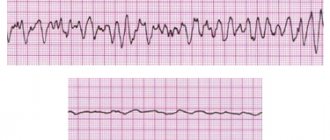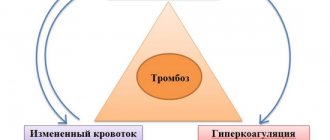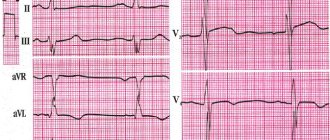Smoking is the cause of increased symptoms of vegetative-vascular dystonia. Inhalation of toxic smoke provokes complications of attacks that will last longer. Nicotine contained in cigarettes leads to changes in parenchymal organs, which negatively affects their functions and worsens the course of other diseases. Therefore, people suffering from dystonia need to say goodbye to smoking forever.
- Symptoms of VSD in a smoker
- Why does smoking worsen the course of VSD?
- Smoking with hypotensive dystonia
- Smoking in hypertensive form of VSD
- Smoking in cardiac (heart) and respiratory forms of VSD
- Quitting smoking with VSD
- Reviews
Symptoms of VSD in a smoker
If a person with many years of smoking experience is asked about his usual sensations, he will first of all list symptoms such as weakness, headache and weather dependence.
Why does smoking worsen the course of VSD?
Nicotine, which is part of cigarettes, is similar in its mechanism of action to acetylcholine, a mediator of the central nervous system. The main function of this substance is to transmit impulses. When smoking, a number of neuron receptors change natural acetylcholine to nicotine, which leads to activation of the nervous system and increased arousal.
But such an artificial and unnecessary analogue leads to the depletion of natural reserves of acetylcholine and also negatively affects its production. In order for nerve impulses to be activated in the future, they already need constant “feeding” with nicotine.
How does the smoking habit become established?
- When smoking a cigarette, blood flow to the brain cells increases; this change, although short-lived, causes a feeling of euphoria and relaxation. A feeling of emotional uplift when consuming nicotine is fixed in the mind. Therefore, to improve your mood you just need to smoke. This feeling is deceptive and works at first. If you ask “experienced” smokers, it turns out that long-term smokers do not have euphoria, but do have the habit of smoking.
- Psychological dependence develops. Often smoking is a way to carry on a conversation, keep your hands busy, or relax during your lunch break. These habits prevent a person from quickly getting rid of nicotine addiction. A person who quits a destructive habit does not have enough willpower to withstand several weeks. Nevertheless, the psychological dependence weakens significantly and then passes.
The main target of nicotine coming from cigarette smoke is the cells of the nervous system. With VSD, there is already a disorder in the functioning of autonomic mechanisms, and nicotine significantly aggravates the manifestations of the disease.
What harm the body will receive depends on the form of VSD, as well as on the quality and number of cigarettes smoked daily.
Smoking with hypotensive dystonia
The hypotensive form is manifested by a decrease in blood pressure below the usual, normal age norm. Due to this, a person is often bothered by headaches, weakness, drowsiness, decreased activity and performance, and fainting is possible during an attack. If a person smokes with this form of dystonia, he will often develop the following symptoms:
- Exhaustion of the nervous system as a result of impaired production of acetylcholine, which ultimately leads to increased asthenic symptoms - weakness, decreased performance, apathy.
- Disturbances in the functioning of the heart . After smoking, the heart rate temporarily increases. Due to short pauses between heartbeats, ischemic zones may appear in the myocardium, because nicotine leads to vasospasm, including coronary ones.
- Ischemic disorders in the brain . In smokers with VSD and low blood pressure, the risk of stroke increases several times due to the chronic development of hypoxia and ischemia.
The longer and more you smoke, the greater the risk of the consequences of smoking, which will be difficult to completely eliminate.
Smoking in hypertensive form of VSD
With the hypertensive variant of the course of dystonia, the blood pressure level rises above the age norm. A person is often bothered by headaches, dizziness, and nausea. Tobacco smoking leads to the following consequences:
- Spasms and narrowing of blood vessels, and this significantly increases blood pressure. A constant supply of nicotine triggers many pathological mechanisms that lead to persistently high blood pressure.
- The appearance of disturbances on the internal walls of blood vessels. Harmful substances from tobacco (tars, benzopyrene, radioactive isotopes) settle inside the vessels. With constantly elevated blood pressure, conditions are created that allow toxins to penetrate deep into the tissues, which contributes to the formation of damage.
- The formation of atherosclerotic plaques that clog blood vessels, creating conditions for the occurrence of vascular accidents - heart attack and stroke.
Smoking in the hypertensive form of dystonia creates conditions for increased blood pressure and also causes a more severe course of VSD.
Smoking in cardiac (heart) and respiratory forms of VSD
The cardiac variant of VSD is manifested by stabbing pain in the region of the heart, a feeling of “failures” in its work, and arrhythmia. Each cigarette smoked in the cardiac form of VSD increases tachycardia and causes spasm of blood vessels. As a result, pronounced pains of a pressing, squeezing, stabbing nature appear, which are difficult to distinguish from angina pectoris or even a heart attack.
Respiratory dystonia is characterized by a feeling of lack of air, shortness of breath. Smoking impairs the oxygen saturation of the blood, so the reflex form of shortness of breath that occurs with dystonia develops into a somatic disease, which is much more difficult to cure than a functional disorder. When smoking, the processes of physiological cleansing of the bronchial tree are quickly disrupted, and the ciliated epithelium is inhibited. Therefore, smokers experience bronchitis, tracheitis, and laryngitis longer and more severely, and the risk of developing asthma increases.
Long-term smoking can provoke the development of dystonia. If you smoke while the disease is already developing, the attacks will be more frequent, longer lasting, and more severe in symptoms.
Tobacco smoking during VSD increases the exhaustion of the nervous system, leads to depressive states, increases anxiety, and increases irritability.
It is imperative to quit a bad habit, and it is better to do this under the supervision of a doctor.
Quitting smoking with VSD
Quitting smoking is not easy, but it is possible. It’s good if a person assessed all the negative consequences of nicotine use in time and began to fight addiction even before addiction. In this case, it is possible to quit smoking without significant stress.
When quitting smoking, the symptoms of dystonia intensify. The fact is that the dose of nicotine entering the body gives imaginary relaxation and improves mood. But these are false feelings. Cigarettes lead to pathological disorders in the body, which cause aggravation of VSD.
Quitting smoking at first causes a lot of unpleasant sensations, and even worsening attacks of dystonia. Therefore, it is better to develop measures in advance that will make it easier to survive psychological dependence.
When fighting nicotine addiction, try to adhere to the following:
- Plan to give up cigarettes during your vacation or specially go to another city for a while. In a new place, there is less influence of those factors that enhance psychological attraction.
- Improve your nutrition . Eat more fortified foods, natural products.
- Drink more water. Replace tea with decoctions of soothing herbs; if you want to smoke, it is recommended to drink them in small sips.
- Increase physical activity . Exercising calms the nerves, distracts you from the desire to smoke, and removes toxins along with sweat.
- Learn breathing exercises . Deep breathing saturates the cells with oxygen and relaxes, therefore making it easier to wean yourself off cigarettes.
- Take more walks in the fresh air . Evening walks calm you down, improve your mood and make you sleep better at night. It is advisable to travel more often to the forest, to the river, to ecologically clean areas.
- Find something you like. Doing something you love will distract you from thoughts about smoking, which often fill the spiritual and practical vacuum.
- If you have a long history of smoking, consult your doctor about what medications will help you overcome the craving for cigarettes. Today on the shelves of pharmacies there are many drugs against nicotine addiction that make you feel better and calm you down. Temporarily, the doctor will prescribe sleeping pills to improve sleep, which will have a positive effect on your mood.
- Physical dependence on nicotine lasts for several days. Next, the psychological habit acts more, which you fight in every possible way. You shouldn’t let yourself relax and allow yourself to smoke one cigarette, because this will delay the start of a healthy life, and you’ll have to start all over again.
Vegetative crises
VSD occurs as a chronic disease with periods of exacerbation. These exacerbations are called vegetative crises.
- Sympathoadrenal vascular crisis is manifested by rapid heartbeat, facial flushing, increased blood pressure (BP), chills, cold extremities and sudden agitation.
- A vagoinsular crisis, or a crisis of the hypotonic type, begins with general weakness, shortness of breath, sudden sweating, a feeling of cardiac arrest, and a decrease in blood pressure.
- Mixed type of crisis with VSD - the symptoms of both crises are combined.
In addition, people suffering from VSD may experience phobias, self-doubt, mood lability, panic attacks (PA) and inability to concentrate. The appearance of such complaints can push a person to become addicted to some bad habits, such as smoking.
Nutrition rules for VSD
The diet for VSD depends on the patient’s weight, manifestations of digestive dysfunction, and the patient’s gastronomic preferences. Particular attention is paid to the diet of overweight patients. Rehabilitation specialists offer an individual weight loss program. It includes not only dietary nutrition, but also physical therapy, some sports, and a water regime.
For all patients suffering from changes in blood pressure, doctors recommend:
- streamline your diet (meals should be taken at approximately the same time, eat at least 6 times a day in small portions);
- limit the consumption of fats and easily digestible carbohydrates;
- avoid fried foods, smoked foods, fast food;
- limit alcohol consumption;
- give preference to foods that are sources of fiber (whole grain pasta, vegetables, leafy greens, legumes, fruits, nuts, oatmeal, bran, seaweed);
- add linden blossom, hop cones, peppermint or lemon balm leaves to the tea brew (they regulate hypothalamic-visceral interactions, normalize sleep, and reduce irritability).
In case of hypertensive form of VSD, you should:
- limit coffee consumption to 2-3 cups per day, replace strong tea or coffee with cocoa, which contains flavonol, which reduces blood pressure;
- reduce the consumption of alcoholic beverages, give preference to red wine, which contains antioxidants;
- avoid dishes that stimulate the central nervous system (rich fish and meat broths);
- reduce the daily amount of table salt to 4–6 g, not using it when cooking, but adding salt to ready-made dishes, or using hyposodium salt and its potassium substitutes;
- increase in the diet the proportion of foods that are sources of potassium (eggplant, baked potatoes, apricots, paprika, grapes, tangerines, cottage cheese) and magnesium (buckwheat, nuts, wheat germ, bran, sesame).
For patients suffering from the hypotonic type of VSD, nutritionists recommend eating foods rich in vitamin C and drinking rosehip decoction. They should avoid fasting diets and fasting days. Food should be taken every 3 hours in small portions. It is necessary to drink at least 1.5 liters of water per day, since fluid is necessary to maintain a sufficient volume of circulating blood.
Products should contain large amounts of ascorbic acid. There is a lot of it in black currants, gooseberries, bell peppers, citrus fruits, sea buckthorn, rutabaga. It is necessary to use fruits and vegetables with bioflavonoids, which improve the elasticity of blood vessels (beets, paprika, oranges). Don't forget about leafy greens, dill, and celery. Their essential oils dilate blood vessels. Freshly squeezed juices from these vegetables and fruits are beneficial. It is not recommended to use tonic spices (turmeric, ginger, cinnamon, chili pepper) in the preparation of hot dishes, desserts, side dishes, and baked goods. Knownly salty foods should be avoided.
What do habits and illness have in common?
What do smoking and VSD have in common? First of all, you should consider what changes in the body occur after smoking a cigarette due to nicotine entering the body.
How does the body react to smoking a cigarette? After smoking one cigarette, the following vegetative changes occur in the human body:
- The heartbeat quickens and pulsation appears in the temples, blood pressure rises due to the release of adrenaline and vasospasm.
- Possible severe agitation or PA.
- In some cases, arrhythmia appears.
- Dizziness occurs when you puff too hard.
- It is possible to develop a headache due to spasm of cerebral vessels.
These symptoms get worse if you smoke 2 or more cigarettes one after another.
Reviews from doctors about the dangers of smoking indicate that it provokes not only metabolic disorders, which can lead to atherosclerosis of blood vessels, but smoking also causes a sharp spasm of the body’s blood vessels, which leads to impaired blood circulation and the appearance of dizziness, a feeling of “interruptions” in the functioning of the heart , headache. Therefore, smoking with VSD can intensify symptoms and aggravate the course of the disease.
How smoking affects cardiovascular activity
A smoker's heart beats faster (up to 80-90 beats per minute).
Carbon monoxide, which cigarette smoke brings into the body, reduces the amount of oxygen entering organs that are very important for life. Oxygen starvation has a very negative effect on the vital resource of the heart.
Increased blood clotting. Because of this, blood clots may appear in the blood vessels and heart cavity. If the blood clot breaks, and this almost always happens suddenly, the person may experience a myocardial infarction, cerebral stroke, or pulmonary infarction.
The negative effect is also due to the high concentration of nicotine, which affects the decrease in the level of the hormone prostacyclin and damage to cell membranes. A decrease in the level of this hormone can lead to a disease that affects the smoker's heart. It will also accelerate the course of an existing disease.
Cholesterol in the blood increases, and the level of blood lipids, betaliproprotein, also increases. This contributes to the formation of atherosclerotic plaques, which prevent blood flow to the heart. The negative consequences of atherosclerosis are myocardial infarction, ischemic disease and even sudden death.
Development of a vicious circle
Let's consider the development of a vicious circle: illness and bad habit.
Smoking leads to exhaustion of the nervous system, which further aggravates the symptoms of VSD. And constant nervous tension and a feeling of uncertainty and nervousness, which are typical for patients suffering from vegetative-vascular dystonia, push a person to smoke. Thus, a vicious circle results: the habit of smoking provokes VSD, and the disease itself pushes one to light a cigarette. This snowball is constantly piling up and makes it impossible to defeat this disease. In addition, smoking against the background of VSD can provoke PA.
The disease should not be underestimated, since if treatment is not started in a timely manner, it can cause the development of other diseases of the cardiovascular system - hypertension.
The target of nicotine is the vessels of the whole body, but especially the vessels of the heart. Increased heart rate after smoking increases the myocardial need for oxygen, but the vessels affected by nicotine cannot provide this, so hypoxia of the heart muscle occurs.
Note! The same changes are observed in the vessels of the brain.
Therefore, the question of whether it is possible to smoke with VSD can be answered unequivocally - of course, NO. Nicotine addiction causes constant internal tension. In emotionally labile people, this can provoke panic attacks or the development of prolonged depression.
Alternative to cigarettes and alcohol
Even if desired, it is much more difficult for patients with VSD to get rid of nicotine or alcohol addiction than for other people. But if you gather your strength, it can be done. For example, when fighting smoking, you can try to replace cigarettes with drinks made from natural coffee beans. They also stimulate blood circulation in the brain well and have much less negative effect on the body.
Instead of alcohol, a frequently occurring nervous state can be eliminated with the help of sedative medications, available in pharmacies without prescriptions.
The combination of relaxants and tonic coffee allows you to stabilize the condition of patients with VSD and bring it back to normal. But you should understand that any medications and coffee should be taken only in reasonable amounts without abuse.
The diagnosis of vegetative-vascular dystonia is in no way combined with smoking, and especially with an addiction to alcoholic beverages. Such desires only shorten life expectancy and significantly worsen the condition of patients. But, despite this, many patients find ways to temporarily get rid of the symptoms of this disease and get the desired relief. In order not to ruin your health, it is worth thinking about ways to eliminate the manifestations of VSD that do not cause harm to the body.
Following simple rules for prevention
Prevention of VSD consists of following simple rules:
- Active lifestyle and following healthy eating rules.
- Sanitation of chronic foci of infection.
- Getting rid of bad habits - smoking.
- Be sure to alternate work with rest.
- Avoiding stressful situations to prevent PA.
- Having healthy, full sleep.
In addition, treatment of VSD begins with lifestyle modification - normalization of work and rest and daily gymnastics.
Respiratory system diseases
Very often, dystonia leads to breathing problems. A person who smokes feels all the negative symptoms of this disease several times more strongly:
- Lack of oxygen.
- Heavy breathing after smoking a cigarette.
- Dizziness from lack of oxygen.
As a result of nicotine abuse, a disease such as bronchial asthma can develop.
Quitting the habit, but avoiding the consequences
We will describe how to quit smoking without consequences. A person quitting smoking may experience anxiety, malaise, and internal tension due to a lack of nicotine in the body. Therefore, in order not to relapse, quitting smoking should be replaced with some exercises that can facilitate the process of getting rid of the bad habit.
- Perform breathing exercises.
- As prescribed by your doctor, you can additionally take sedatives or anxiolytics, which will help you cope with addiction more easily.
- Smoke breaks with colleagues can be replaced with a shared tea party, and a cigarette in your mouth with candy.
It should be remembered that VSD and smoking are incompatible things, since nicotine addiction aggravates the course of the disease and increases the risk of complications.
What can be done if your condition worsens sharply after drinking and smoking?
When patients with VSD experience a severe reaction after drinking alcohol, they need emergency care. First of all, it is necessary to reduce the excitability of the subcortical centers of the ANS through sedatives. Such products are sold at any pharmacy and are available without a prescription. Therefore, the home medicine cabinet of patients with vegetative-vascular dystonia must contain the following medications:
- Valerian or motherwort extract. You can also use tinctures based on motherwort or hawthorn.
- Tranquilizers, for example, Sibazon or Diazepam. Long-term use of this group of medications can cause dependence, so they are available only with a doctor's prescription.
- Agents with a beta-adrenergic blocking effect (Atenolol, Anaprilin).
- Antispasmodics and enterosorbing agents.
Before purchasing any medications, you should consult with your doctor in advance about the rationality of their use in certain situations.
Smoking and VSD
If we say that smoking in general is a bad habit and negatively affects a healthy human body, then with VSD this addiction significantly undermines the functioning of the entire body. The symptoms of VSD are directly related to a malfunction of the central nervous system. Against the background of her disorder, various painful phenomena arise: depression, panic attacks, phobic reactions. All this happens due to a reboot of the nervous system. And constant insomnia, headaches and excessive psycho-emotional and physical stress can lead to the development of the apathetic stage of the disease.
Smoking often only worsens the symptoms of VSD. The greatest misconception among smokers is that smoking cigarettes calms the nerves. During times of nervous tension, the number of cigarettes smoked increases, which means that more harmful substances enter the body, which have a negative effect on health.
In a word, smoking and VSD are incompatible. In the presence of such a harmful addiction as smoking, VSD can develop into a severe form with serious and sometimes irreversible consequences.
Many smokers claim that if you quit smoking, VSD will not disappear, which means that smoking does not depend in any way on the number of cigarettes smoked. However, scientists have proven that if a patient quits smoking, the body’s protective functions will be restored over time, return to normal, and the symptoms of VSD will gradually begin to disappear.
Causes of VSD
Many doctors believe that VSD is a consequence of psycho-emotional stress, when general well-being worsens and internal organs stop working correctly. There are many reasons for the appearance of VSD: long-term depression and constant stressful situations, incorrectly calculated physical and emotional stress, sleep problems, reduced immunity, spinal diseases, and a sedentary lifestyle.
Reviews from doctors indicate that several causes intersecting at the same time are sufficient to initiate the outbreak of the disease, thereby comprehensively disrupting autonomic regulation.
One of the sources of VSD is the presence of bad habits in a person’s life – smoking and alcohol abuse. All people know about the dangers of smoking, but not everyone has information about whether you can smoke if you have VSD.
Smoking and psychology
Constant stress and depression, apathy and anxiety force the smoker to smoke one cigarette after another to obtain the illusion of “salvation” and “calm.” Smoking creates a protective screen for the smoker, behind which they hide from the outside world and other troubles during VSD. But this is only a psychological deception, which subsequently leads to the transition of VSD to a severe form, and the passion for smoking to nicotine addiction.
From the above, we can conclude that stress gives rise to the desire to smoke, and smoking itself with VSD only further destroys the body.










